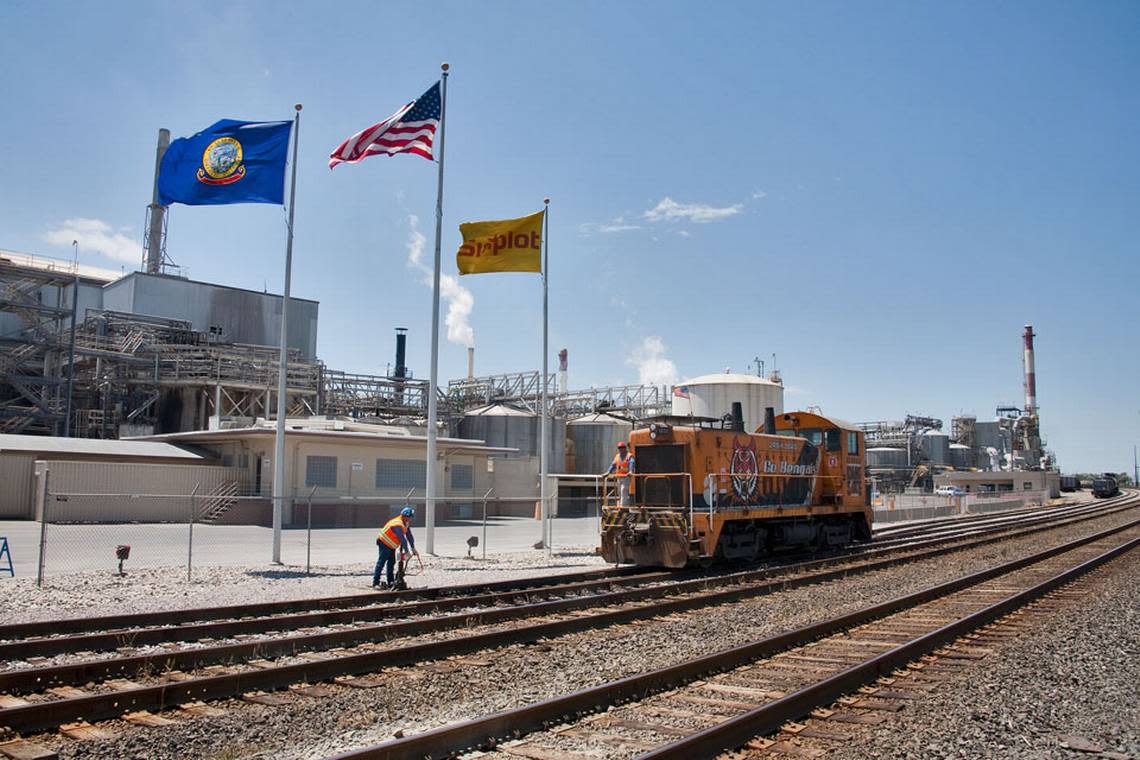Boise ag giant Simplot signs Idaho pollution decree with prosecutors. What happened

- Oops!Something went wrong.Please try again later.
Agribusiness giant J.R. Simplot has agreed to pay more than $150 million in a settlement with the U.S. Department of Justice and the Environmental Protection Agency to resolve allegations of environmental damage from a plant near Pocatello.
The department alleged that Simplot’s Don Plant, which manufactures fertilizer, violated the Resource Conservation and Recovery Act and Clean Air Act, according to a consent decree describing the settlement.
The government alleged that the plant illegally treated, stored or disposed of waste generated by manufacturing, including phosphoric acid and fertilizers, and allowed fluoride emissions from its cooling towers that exceeded federal limits. Simplot disputes the allegations, according to the decree.
The Don Plant began operating in the 1940s, according to the EPA. It produces liquid and solid fertilizers using phosphate ore, sulfur, air and natural gas. It’s located in the Eastern Michaud Flats Contamination Site, a 2,530-acre area where groundwater and soil were contaminated by operations at Simplot’s plant and a different plant that closed in 2001.
Under the settlement with the Justice Department and EPA, Simplot expects to pay $150 million to reduce environmental impacts from the plant and a $1.5 million civil penalty, according to a news release.
To reduce environmental damage, the company will cease operation of the plant’s cooling towers by July 2026 and replace them with cooling ponds to significantly reduce fluoride emissions, according to the release. The plant will also stabilize its gypsum stack — a pile of waste products generated in fertilizer manufacturing — and maintain $108 million in funding for an environmentally sound closure of the plant, according to the release.
“This settlement will bring important benefits to Idaho and the communities that have been affected by the Don Plant’s operations,” said Josh Hurwit, U.S. attorney for Idaho, in the release.
In a email to the Statesman, Josh Jordan, Simplot’s associate director of communications and public relations, wrote that the settlement provides for additional recovery of phosphate in the plant’s production process and in other environmental protection measures involved in handling ores and waste.
“This settlement is part of our work to continue to provide important crop nutrients throughout North America to help feed a growing population,” Jordan wrote.
The consent decree was filed in the U.S. District Court of Idaho on Tuesday and will be available for 30 days of public comment before a federal judge considers it for approval.
Simplot in 1998 agreed to clean up pollutants
A cleanup plan for the site, called a Record of Decision, was first issued by the EPA in 1998. Simplot agreed then to take a set of actions to clean up pollutants. They included building a groundwater extraction system to contain contaminants from its gypsum stack, or gypstack, excavating contaminated soils from a dewatering pit and overflow pond, and monitoring groundwater and fluoride emissions.
In 2010, the EPA amended the original plan by adding phosphoric acid as a contaminant of concern and identifying it as a large culprit for declining water quality nearby. Water used to carry the waste products of fertilizer manufacturing was trickling into the groundwater from the gypstack, according to the amendment, releasing significant quantities of phosphorous into the groundwater.
The polluted groundwater flowed into the nearby Portneuf River through springs along its banks. It discharged in an area within the Fort Hall Reservation used by members of the Shoshone-Bannock tribes for hunting, fishing and gathering, according to Tuesday’s consent decree.
Additional environmental remediation actions were required beyond those required in the original plan to address the problems, including adding a synthetic liner to the gypstack to prevent leaks of acidic wastewater and developing a plan to control sources of phosphorous from the plant.
As part of its remediation activities over the course of the cleanup, Simplot has placed multiple monitoring and extraction wells throughout the Don Plant and sampled and analyzed groundwater and soil to determine the nature and extent of hazardous substances from the plant, according to the consent decree.
The company completed the liner for its gypstack in 2017 and agreed to develop a plan to address a liner failure.

